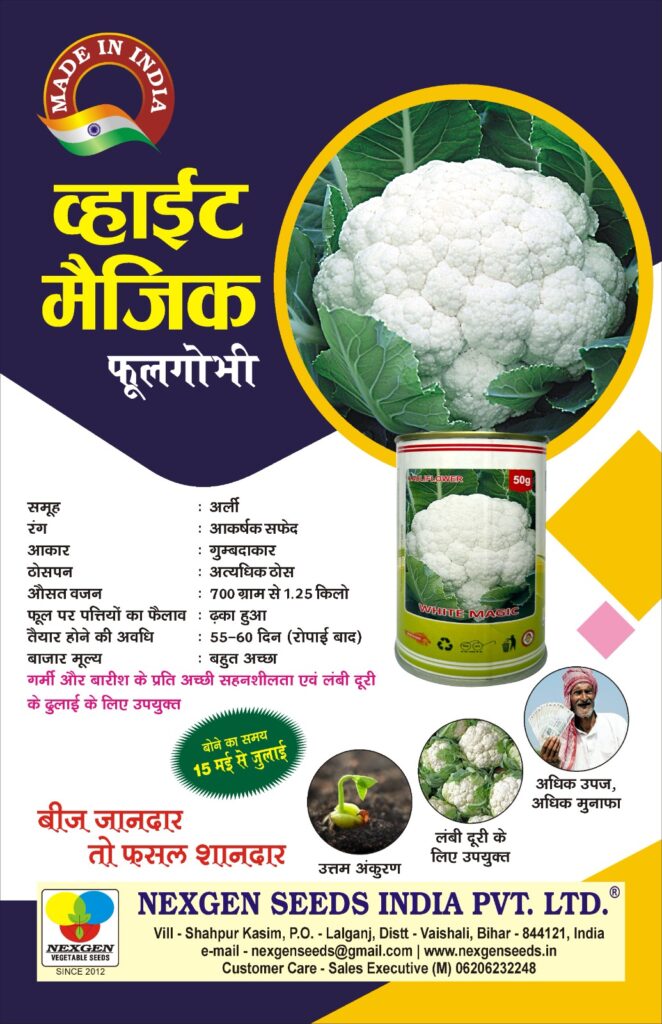Introduction
Cauliflower is a nutritious and versatile vegetable that has gained popularity globally in recent years. Whether you’re a seasoned farmer or a gardening enthusiast, maximizing cauliflower production is always a rewarding endeavour. In this blog post, we’ll discuss 25 effective steps to boost cauliflower production effortlessly. By implementing these techniques, you can increase yields, improve the quality of your harvest, and ensure a bountiful cauliflower crop.

- Select the Right Cauliflower Variety
Choosing the appropriate cauliflower variety is crucial for successful production. Consider factors such as climate, growing season, and disease resistance to select a variety that suits your specific conditions.
- Start with Healthy Seeds
Using high-quality seeds from reputable sources ensures healthy and disease-free cauliflower plants. opt for certified Nexgen seeds whenever possible.
- Prepare the Soil
Cauliflower thrives in well-drained, fertile soil. Prior to planting, enrich the soil with organic matter like compost or well-rotted manure to improve its structure and nutrient content.
- Optimal Planting Time
Plant cauliflower during the appropriate season, depending on your location. Generally, cauliflower prefers cooler temperatures, so plan your planting accordingly.
- Adequate Sunlight
Ensure your cauliflower plants receive at least six hours of direct sunlight daily. Full sun exposure promotes healthy growth and helps prevent diseases.
- Proper Spacing
Allow sufficient space between cauliflower plants to ensure good air circulation, which reduces the risk of fungal diseases. Space plants about 18-24 inches apart, depending on the variety.
- Provide Regular Watering
Cauliflower requires consistent moisture for optimal growth. Water deeply but avoid over-watering, as it can lead to rotting. Provide Regular Watering to keep the soil evenly moist throughout the growing season.
- Mulching
Apply a layer of organic mulch around cauliflower plants to retain moisture, suppress weeds, and maintain a more stable soil temperature.
- Fertilize Regularly
Feed your cauliflower plants with a balanced organic fertilizer or compost tea every two to three weeks. Fertilize Regularly provides essential nutrients and promotes healthy growth.
- Monitor pH Levels
Maintain a slightly acidic soil pH between 6.0 and 7.0 for optimal cauliflower production. Regularly test the soil and make necessary adjustments using organic soil amendments if needed.
- Proper Weed Control
Regularly remove weeds around your cauliflower plants to prevent competition for nutrients and water. Mulching and hand weeding are effective methods for weed control.
- Monitor Pests and Diseases
Be vigilant for common cauliflower pests such as aphids, cabbage worms, and slugs. Use organic pest control methods like companion planting, neem oil, or insecticidal soaps to manage infestations.
- Companion Planting
Plant cauliflower alongside companion plants like onions, celery, or dill. These plants can naturally deter pests and improve overall cauliflower health.
- Provide Wind Protection
Cauliflower plants can be sensitive to strong winds. Consider using windbreaks or planting cauliflower near structures that provide natural wind protection.
- Support the Heads
As the cauliflower heads develop, gently tie the outer leaves together to protect the heads from sunlight. This process is called “blanching” and helps maintain the creamy white colour.
- Regularly Inspect for Maturity
Monitor your cauliflower plants closely to identify when the heads are mature and ready for harvest. Harvesting too early or too late can affect the flavour and quality of the cauliflower. Look for firm, compact heads with a creamy white colour. Avoid heads that have started to turn yellow or brown.
- Harvesting Techniques
To harvest cauliflower, use a sharp knife or garden shears to cut the head off the plant, leaving a few inches of stem attached. Be careful not to other developing heads or damage the surrounding leaves. Harvesting in the morning when the heads are cool can help preserve their freshness.
- Succession Planting
To enjoy a continuous harvest throughout the season, practice succession planting. Start new cauliflower plants every few weeks, staggering their maturity dates. This ensures a steady supply of fresh cauliflower.
- Crop Rotation
Rotate your cauliflower crops each year to prevent the buildup of pests and diseases in the soil. Avoid planting cauliflower, as well as other members of the Brassica family, in the same location for consecutive seasons.
- Maintain Good Garden Hygiene
Clean up plant debris and remove any diseased or infested plants promptly. This reduces the risk of pests and diseases spreading to healthy cauliflower plants.
- Pruning and Thinning
When the cauliflower plants reach a certain size, consider pruning and thinning to improve airflow and reduce competition for nutrients. Remove any damaged or overcrowded leaves and thin out smaller heads to allow the larger ones to develop fully.
- Protect from Extreme Temperatures
Cauliflower is sensitive to extreme temperatures, so take precautions during heatwaves or cold snaps. Provide shade or coverings during hot weather and use row covers or cloches to protect plants from frost.
- Proper Storage
After harvesting your cauliflower, store it properly to maintain freshness. Remove excess leaves and store the heads in a cool, dry place. Cauliflower can be refrigerated for up to a week but is best when consumed shortly after harvest.
- Learn from Experience
Keep a gardening journal to track your cauliflower production, noting the varieties you’ve grown, planting dates, and any challenges or successes encountered. This information will help you refine your techniques and improve future harvests.
- Continuous Learning
Stay informed about the latest techniques and advancements in cauliflower production. Join gardening communities, attend workshops, and read reputable gardening resources to expand your knowledge and enhance your gardening skills.
Conclusion
By following these 25 steps, you can effortlessly boost cauliflower production and enjoy a plentiful harvest. Remember to select the right variety, provide optimal growing conditions, monitor for pests and diseases, and practice good garden management. With patience, dedication, and a little bit of knowledge, you’ll be rewarded with healthy, delicious cauliflower that you can enjoy in various culinary creations. Happy gardening!
Maximizing Yield with Cauliflower Seeds in India

- What are the best varieties of cauliflower for high production?
Some popular cauliflower varieties known for their high production include NXG Delight, NXG White Lady, NXG Tejas, NXG Karishma, NXG Anmol, NXG 172, NXG 911, NXG White Magic, NXG 1033, and NXG Hansa. However, the best variety for you will depend on your specific growing conditions and preferences.
- How much time does it take for cauliflower to mature?
The time it takes for cauliflower to mature can vary depending on the variety and growing conditions. Generally, cauliflower takes around 55-60 and 60 to 65 days from transplanting to harvest. Keep an eye on the size, colour, and firmness of the heads to determine their maturity.
- How can I prevent cauliflower from turning yellow?
Cauliflower heads can turn yellow due to exposure to sunlight, a process known as “sunburn.” To prevent this, practice blanching by tying the outer leaves together to shield the heads from direct sunlight. Additionally, harvest cauliflower heads when they are fully mature to avoid discoloration.
- How often should I water my cauliflower plants?
Cauliflower plants require consistent moisture for healthy growth. Water deeply and regularly, aiming to keep the soil evenly moist. The frequency of watering will depend on factors such as temperature, rainfall, and soil type. Check the soil moisture regularly for healthy growth and adjust your watering schedule accordingly for healthy growth.
- What are some common pests and diseases that affect cauliflower?
Common pests that can affect cauliflower include aphids, cabbage worms, slugs, and flea beetles. Diseases such as clubroot, black rot, and downy mildew can also impact cauliflower plants. Regularly inspect your plants for signs of infestation or disease and take appropriate measures, such as using organic pest control methods or disease-resistant varieties.
- Can I grow cauliflower in containers?
Yes, cauliflower can be grown in containers, but it’s important to choose a large enough container to accommodate the plant’s root system. Ensure the container has good drainage system and use a well-draining potting mix in the containers. Place the container in a sunny location and provide regular watering and fertilization.
- How do I know if my soil is suitable for growing cauliflower?
Cauliflower thrives in well-drained, fertile soil. You can assess your soil’s suitability by performing a soil test. Soil testing kits are available at garden centres or through agricultural extension offices. The test will provide information about the soil’s pH level, nutrient content, and any necessary amendments.
- Is cauliflower a cool-season or warm-season crop?
Cauliflower is considered a cool-season crop. It prefers cooler temperatures for optimal growth and tends to develop poorly in hot weather. It is best to plant cauliflower in early spring or late summer/early fall when temperatures are cooler.
- Can I save seeds from my cauliflower plants?
Yes, you can save seeds from cauliflower plants. However, keep in mind that cauliflower is a biennial plant, meaning it takes two years to complete its life cycle. Saving seeds requires allowing the plant to overwinter and produce a seed stalk in the second year. The process can be more challenging compared to saving seeds from annual plants.
- Can I grow cauliflower year-round?
The ability to grow cauliflower year-round depends on your climate and growing conditions. Cauliflower is typically grown as a cool-season crop in areas with mild winters. However, in regions with hot summers, it can be challenging to grow cauliflower during the hottest months. Consider using shade cloth or providing shade to help protect the plants from extreme heat.
